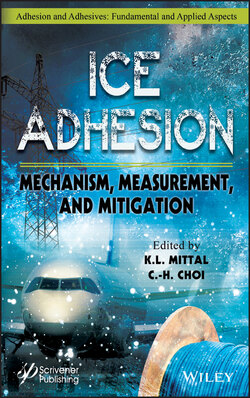Читать книгу Ice Adhesion - Группа авторов - Страница 24
1.4 The Sliding Friction of Ice
ОглавлениеSection 1.3 considered the mechanical separation of ice from a solid substrate to which it had been frozen. Naturally this leads us to next consider the tribology of ice. That is, what occurs when a solid surface is put in relative motion to frozen water? As discussed in Section 1.1.3, human’s employment of the low frictional force of ice for transportation dates back to at least 7000 BCE in Scandinavia where skis allowed people to efficiently navigate and hunt [39]. Another historical use of a low friction surface for transportation comes from an Egyptian carving dated to 2400 BCE. This relief depicts humans pouring a lubricant in front of a sledge to facilitate sliding [127, 128].
Although it is evident that humans have devised methods to deal with friction for millenia, the first explicit mention of friction as a force was not made until Aristoteles’ Questiones Mechanicae circa 350 BCE [127, 128]. Further, the first quantitative studies of friction were not performed until circa 1500 CE by Leonardo da Vinci. Even then, da Vinci’s notes were not published until the end of the 19th century, leaving the opportunity for French physicist Guillaume Amonton to rediscover his two laws of friction in 1699 [127, 128]. These are
1 “Friction produces double the amount of effort if the weight be doubled” i.e. The force of friction is directly proportional to the applied load.
2 “The friction made by the same weight will be of equal resistance at the beginning of its movement although the contact may be of different breadth and length” i.e. The force of friction is independent of the apparent area of contact for a given load.
Amonton also made the important identification of surface roughness being the fundamental cause of friction, with friction being the force required to lift interlocking asperities over one another during their relative sliding motion [127]. In 1785, Charles Augustin Coulomb investigated the effect of various relevant factors on frictional resistance, such as: the material in contact, the surface area, the normal pressure, the length of time that the surfaces remain in contact, and the ambient conditions on frictional resistance. Coulomb’s work was also the first to formulate frictional force as an equation. where FT, FN, and μ are the frictional force, the normal force and the coefficient of friction, respectively. The coefficient of friction in Equation 1.42 is assumed to be independent of the relative sliding velocity, an assumption often referred to as the third law of friction. However, the third law only holds for moderate sliding velocities [127, 128].
(1.42)
As discussed in Section 1.1.3, the Industrial Revolutions ignited much scientific study into ice. In 1859, Michael Faraday showed that two ice cubes will fuse together when brought into contact. He concluded from this observation that the surface of ice is covered with a liquid-like layer [129]. That same year, James Thomson attributed the existence of the liquid-like layer to pressure melting [130]. Osborne Reynolds used Thomson’s pressure melting theory to explain the ease of skating on ice. That is, the pressure of the skater must lead to a thicker liquid-like layer which lubricates the surface of the ice [131]. This theory whence ice derives its low friction force prevailed until 1939 when Bowden, Hughes and Desch suggested the now generally accepted theory that frictional heating is the main contributor to the low coefficient of friction of ice [132].
In this section we will discuss the role that the liquid-like layer plays in determining the frictional force of ice.
